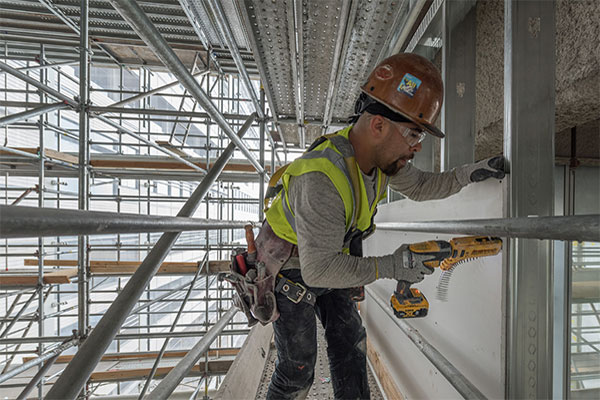Total Guide to Efficient and Dependable Drywall Setup
Drywall setup is an important part of any type of construction or restoration project, demanding a meticulous technique to ensure both effectiveness and integrity. It is vital to explore the subtleties of each step in the process, as they jointly add to the total success of the drywall installation.
Crucial Tools for Drywalling
When starting a drywall installation project, having the right devices is essential for attaining a professional finish. Necessary tools consist of a drywall knife, measuring tape, and a T-square, which are basic for exact measurements and smooth cuts. A drywall lift is additionally highly useful, specifically for ceiling installations, permitting much easier handling of heavy panels.
For fastening the drywall, a cordless drill and drywall screws are required. The drill needs to be furnished with a drywall bit to ensure performance and precision. Additionally, a key tool is the drywall saw, which promotes cutting around various other barriers and electric outlets.

Furthermore, safety equipment such as shatterproof glass and a dirt mask are vital to ensure personal security throughout the installation process. Using the right devices not only improves the high quality of the installation but additionally streamlines the process, making the task more efficient general.
Preparing the Area

Following, evaluate the problem of the ceilings and wall surfaces. Repair any type of existing damage, such as openings, cracks, or peeling paint, to ensure a smooth and even surface for drywall application. Additionally, check for electric outlets, plumbing lines, and HVAC ducts, marking their places to prevent issues during setup.
It is additionally essential to measure the room accurately, identifying the measurements of the ceilings and walls to compute the proper amount of drywall needed. Create a comprehensive strategy that includes the layout and positioning of the drywall panels.
Setup Techniques
Efficient installation methods are crucial for accomplishing a specialist surface in drywall jobs. Appropriate measurement and cutting of drywall sheets are basic steps.
When hanging drywall, start from the leading and job downward, making certain that the lengthy side of the board is vertical to the framing. Secure the sheets with screws as opposed to nails, which provide higher holding power and reduce the risk of standing out. Area screws every 12 learn this here now inches along the sides and every 16 inches in the field of the board.
For edges, make use of edge beads to attain sharp, clean edges. When setting up on ceilings, make use of a drywall lift or have a companion assist in holding the sheets in position (drywall installation). Maintain a gap of about 1/4 inch above the floor and ceiling to accommodate growth and tightening
Ending Up Touches

Begin by applying joint tape over the joints. This can be either paper or fiberglass harmonize tape, with paper being favored for its longevity. When the tape is in location, it's time to use the initial coat of joint compound, likewise referred to as mud. Use a 10 to 12-inch taping blade to spread out description the compound uniformly over the taped seams, feathering the sides to mix with the bordering drywall.
Enable the compound to dry thoroughly, normally 1 day. After drying, sand the surface area lightly with fine-grit sandpaper to remove any flaws. drywall installation. Repeat the mudding and fining sand process, usually 2 to 3 coats, making certain each layer is smooth and flush with the drywall surface
Typical Blunders to Avoid
Lots of Do it yourself fanatics come across pitfalls during drywall installment that can endanger the final results. One usual mistake is falling recommended you read short to properly measure and reduce drywall sheets.
One more regular mistake is inappropriate attachment. Making use of too few screws or nails can bring about loose drywall, while overdriving fasteners can create the paper to tear, damaging the framework. It's critical to keep constant spacing, usually every 16 inches, and to make certain that fasteners are flush with the surface area.
Additionally, not attending to moisture issues prior to setup can cause mold and mildew development and architectural damage. Constantly examine the setting and usage moisture-resistant drywall in high-humidity locations.
Final Thought
Efficient and trusted drywall installment requires precise interest to information throughout the process. Staying clear of usual mistakes further adds to a specialist outcome, emphasizing the significance of precision and method in effective drywall tasks.
It is crucial to discover the subtleties of each action in the procedure, as they collectively contribute to the total success of the drywall setup.When embarking on a drywall installation job, having the right devices is essential for achieving an expert surface.For securing the drywall, a cordless drill and drywall screws are necessary.Effectively preparing the space is important for an effective drywall installment.Efficient setup strategies are essential for attaining a specialist finish in drywall tasks.